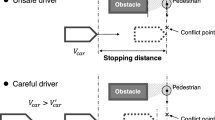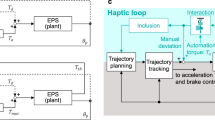Abstract
Contemporary autonomous-driving technology relies on good environmental-perception systems and high-precision maps. For unknown environments or scenarios where perception fails, a human-in-the-loop remote-driving system can effectively complement common solutions, although safety remains an issue for its application. A haptic shared-control algorithm based on non-cooperative game theory is presented in this paper. The algorithm generates collision-free reference paths with model predictive control and predicts the driver’s path using a two-point preview model. Man-machine torque interaction is modeled as a Nash game, and the assist system’s degree of intervention is regulated in real time, according to assessments of collision risk and the driver’s concentration. Simulations of several representative scenarios demonstrate how the proposed method improves driving safety, while respecting driver decisions.
Similar content being viewed by others
References
GALVANI M. History and future of driver assistance [J]. IEEE Instrumentation & Measurement Magazine, 2019, 22(1): 11–16.
GEIGER A, LENZ P, URTASUN R. Are we ready for autonomous driving? The KITTI vision benchmark suite [C]//2012 IEEE Conference on Computer Vision and Pattern Recognition. Providence, RI: IEEE, 2012: 3354–3361.
MULDER M, ABBINK D A, BOER E R. Sharing control with haptics: Seamless driver support from manual to automatic control [J]. Human Factors, 2012, 54(5): 786–798.
BAHRAM M, AEBERHARD M, WOLLHERR D. Please take over! An analysis and strategy for a driver take over request during autonomous driving [C]//2015 IEEE Intelligent Vehicles Symposium (IV). Seoul: IEEE, 2015: 913–919.
CHUCHOLOWSKI F, BÜCHNER S, REICHENEDER J, et al. Prediction methods for teleoperated road vehicles [M]//Conference on future automotive technology-focus electromobility. Wiesbaden: Springer, 2013.
BEĆIRBAŠIĆ D, MOLNAR M, LUKAČ Ž, et al. Video-processing platform for semi-autonomous driving over 5G networks [C]//2017 IEEE 7th International Conference on Consumer Electronics-Berlin (ICCE-Berlin). Berlin: IEEE, 2017: 42–46.
KEYES B, CASEY R, YANCO H A, et al. Camera placement and multi-camera fusion for remote robot operation [C]//IEEE International Workshop on Safety, Security, and Rescue Robotics. Gaithersburg, MD: IEEE, 2006.
GNATZIG S, CHUCHOLOWSKI F, TANG T, et al. A system design for teleoperated road vehicles [C]//Proceedings of the 10th International Conference on Informatics in Control, Automation and Robotics. Reykjavík: IEEE, 2013: 231–238.
MARS F, DEROO M, HOC J M. Analysis of human-machine cooperation when driving with different degrees of haptic shared control [J]. IEEE Transactions on Haptics, 2014, 7(3): 324–333.
ZHANG Q C, WU X C, LIU F. The overview of active front steering system and the principle of changeable transmission ratio [C]//2011 Third International Conference on Measuring Technology and Mechatronics Automation. Shanghai: IEEE, 2011: 894–897.
ERCAN Z, CARVALHO A, LEFÈVRE S, et al. Torque-based steering assistance for collision avoidance during lane changes [C]//13th International Symposium on Advanced Vehicle Control (AVEC’16). Munich: CRC, 2016: 43–48.
SAKAI K, MURAKAMI T. A fusion control of master steering input and automatic assisted control for teleoperated electric vehicle [C]//Proceedings of the IECON 2016-42nd Annual Conference of the IEEE Industrial Electronics Society. Florence: IEEE, 2016: 469–474.
NGUYEN A T, SENTOUH C, POPIEUL J C. Driver-automation cooperative approach for shared steering control under multiple system constraints: Design and experiments [J]. IEEE Transactions on Industrial Electronics, 2017, 64(5): 3819–3830.
SENTOUH C, NGUYEN A T, RATH J J, et al. Human-machine shared control for vehicle lane keeping systems: A Lyapunov-based approach [J]. IET Intelligent Transport Systems, 2019, 13(1): 63–71.
STEELE M, GILLESPIE R B. Shared control between human and machine: Using a haptic steering wheel to aid in land vehicle guidance [J]. Proceedings of the Human Factors and Ergonomics Society Annual Meeting, 2001, 45(23): 1671–1675.
FORSYTH B A C, MACLEAN K E. Predictive haptic guidance: Intelligent user assistance for the control of dynamic tasks [J]. IEEE Transactions on Visualization and Computer Graphics, 2006, 12(1): 103–113.
GUO C S, SENTOUH C, POPIEUL J C, et al. Predictive shared steering control for driver override in automated driving: A simulator study [J]. Transportation Research Part F: Traffic Psychology and Behaviour, 2019, 61: 326–336.
BORRONI F, TANELLI M. A weighting approach to the shared-control of lateral vehicle dynamics [J]. IFAC-PapersOnLine, 2018, 51(9): 305–310.
BRAUN D A, ORTEGA P A, WOLPERT D M. Nash equilibria in multi-agent motor interactions [J]. PLoS Computational Biology, 2009, 5(8): e1000468.
JI X W, YANG K M, NA X X, et al. Shared steering torque control for lane change assistance: A stochastic game-theoretic approach [J]. IEEE Transactions on Industrial Electronics, 2019, 66(4): 3093–3105.
NA X X, COLE D J. Game-theoretic modeling of the steering interaction between a human driver and a vehicle collision avoidance controller [J]. IEEE Transactions on Human-Machine Systems, 2015, 45(1): 25–38.
LUDWIG J, GOTE C, FLAD M, et al. Cooperative dynamic vehicle control allocation using time-variant differential games [C]//2017 IEEE International Conference on Systems, Man, and Cybernetics (SMC). Banff, AB: IEEE, 2017: 117–122.
POPOVSKI P. Ultra-reliable communication in 5G wireless systems [C]//Proceedings of the 1st International Conference on 5G for Ubiquitous Connectivity. Levi: ICST, 2014.
DONG Y C, HU Z C, UCHIMURA K, et al. Driver inattention monitoring system for intelligent vehicles: A review [C]//2009 IEEE Intelligent Vehicles Symposium. Xi’an: IEEE, 2009: 875–880.
VICENTE F, HUANG Z H, XIONG X H, et al. Driver gaze tracking and eyes off the road detection system [J]. IEEE Transactions on Intelligent Transportation Systems, 2015, 16(4): 2014–2027.
Acknowledgment
The authors would like to thank the university and this project’s collaborating automobile manufacturer for providing the required equipment and software for our experiments.
Author information
Authors and Affiliations
Corresponding author
Additional information
Foundation item
the National Natural Science Foundation of China (No. 51775331)
Rights and permissions
About this article
Cite this article
Qiao, B., Li, H. & Wu, X. Intelligent-Assist Algorithm for Remote Shared-Control Driving Based on Game Theory. J. Shanghai Jiaotong Univ. (Sci.) 26, 615–625 (2021). https://doi.org/10.1007/s12204-021-2351-z
Received:
Accepted:
Published:
Issue Date:
DOI: https://doi.org/10.1007/s12204-021-2351-z




